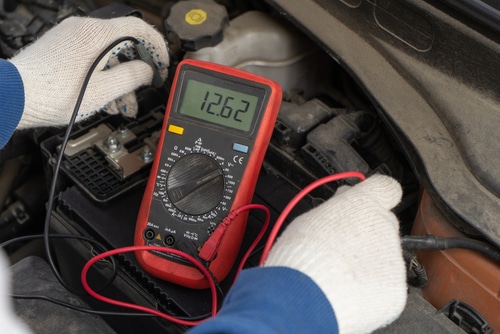Ever had your check engine light flicker on like an unwelcome Christmas decoration?
If you’ve got a P0042 code lighting up your dashboard, you’re in for a treat. This pesky little trouble code is all about the HO2S Heater Control Circuit for Bank 1 Sensor 3. Don’t worry, it’s not as complicated as it sounds.

Your car’s oxygen sensors are like tiny chemists, constantly sniffing out the exhaust to help your engine run efficiently.
When the heater for one of these sensors goes on the fritz, your car’s computer throws a fit and tosses out this P0042 code. It’s like your car is saying, “Hey, I can’t warm up my nose properly!”
Now, before you start imagining your car with a runny nose, let’s break down what this means for you and your trusty steed.
This OBD-II diagnostic trouble code could be causing your engine to guzzle more fuel than a thirsty camel or even run a bit rough. But don’t fret – with a little know-how, you’ll be back on the road in no time.
Key Takeaways
- P0042 indicates a problem with the oxygen sensor heater circuit in your car’s exhaust system.
- Symptoms can include reduced fuel efficiency and a persistently illuminated check engine light.
- Fixing the issue may involve replacing the faulty oxygen sensor or repairing wiring problems.
Decoding the Trouble Code
Alright, buckle up, gearheads! Let’s dive into the mysterious world of P0042. It’s not a secret agent code, but it might as well be for all the confusion it causes.
P0042 is your car’s way of saying, “Hey, I’ve got a problem with my heated oxygen sensor!”
Specifically, it’s pointing fingers at Bank 1, Sensor 3. Don’t worry, your car isn’t turning into a bank robber.
Here’s the breakdown:
- HO2S = Heated Oxygen Sensor
- Bank 1 = The side of the engine with cylinder #1
- Sensor 3 = The third O2 sensor in line
Your engine control module (ECM) is like a helicopter parent, always checking on that oxygen sensor.
When it notices the heater circuit acting up, it throws this code faster than you can say “check engine light.”
Why does this matter?
Well, your O2 sensor is like a nose for your exhaust system. It sniffs out the air-fuel ratio and helps your engine run efficiently. The heater? It’s there to warm up the sensor so it can start working its magic ASAP.
So when you see P0042, your car’s basically telling you, “My nose is cold, and I can’t smell the exhaust properly!” Not the most pleasant image, but hey, cars have feelings too!
Symptoms of the P0042 Code

Got a P0042 code lighting up your dashboard? Don’t panic, but don’t ignore it either! This pesky little code can cause some noticeable issues with your ride.
First off, you’ll likely see that annoying check engine light glowing like a miniature sun on your dash. It’s your car’s way of saying, “Hey buddy, we need to talk!”
You might notice your engine’s running rougher than a cat in a bathtub. That smooth purr you’re used to? It might sound more like a grumpy growl now.
Feeling like you’re visiting the gas station more often?
That’s because your fuel economy might take a hit. Your wallet won’t be too happy about that!
Here’s a fun little list of other symptoms you might encounter:
- Increased emissions (Mother Nature’s giving you the stink eye)
- Poor engine performance (Your car’s gone from racehorse to lazy donkey)
- Stalling or hesitation (Like your car’s playing an awkward game of stop-and-go)
Remember, your car’s trying to tell you something. So, listen up and get it checked out before these symptoms turn into bigger, wallet-draining problems!
Potential Causes and Diagnostics

Hey there, gearhead! Got a P0042 code lighting up your dash like a Christmas tree? Let’s pop the hood and take a look at what might be causing this pesky problem.
First up, the usual suspect: a faulty oxygen sensor. These little guys can throw in the towel after years of hard work. But don’t jump to conclusions just yet!
Wiring issues are another common culprit. You might have some frayed friends hiding in your engine bay. Time for a quick game of “spot the bare wire”!
• Corroded connections
• Damaged wiring harness
• Loose plugs
Don’t forget about the blown fuse possibility. It’s like the circuit breaker of your car – sometimes it just needs a reset.
Now, let’s talk diagnostics.
Grab your trusty multimeter and get ready for some detective work. You’ll want to check the continuity of that heater circuit. It’s like following a trail of breadcrumbs, but with electrons!
A visual inspection is always a good start. Look for any obvious damage or corrosion. Sometimes the problem is right in front of your nose!
Remember, diagnosing these issues can be trickier than getting gum out of your hair.
If you’re not comfortable poking around, there’s no shame in calling in the pros. Better safe than sorry, right?
Exploring Solutions
Alright, buckle up! It’s time to get your hands dirty and fix that pesky P0042 code. First things first, let’s talk about the heated oxygen sensor. This little gizmo might be the culprit behind your troubles.
Got your trusty multimeter? Good!
Check the sensor’s heater circuit for continuity. If it’s giving you the silent treatment, you might need to replace it. Don’t worry; it’s not as scary as it sounds.
Next up, take a gander at that fuse box. The heated oxygen sensor fuse might have decided to call it quits. Replace it if needed, and cross your fingers!
Still seeing that annoying check engine light?
Time to break out the big guns – your OBD-II scanner. Clear those trouble codes and see if they come back. Sometimes, your car just needs a clean slate.
If all else fails, you might need to consider replacing the oxygen sensor. It’s not the cheapest fix, but it beats driving around with a glowing dashboard, right?
Remember, the cost to fix P0042 can vary. If you’re handy with a wrench, you might save some cash. But if you’re all thumbs, a trip to the mechanic might be in order. Either way, your wallet will thank you for solving this sooner rather than later!
Impact on the Vehicle
Got a P0042 code lighting up your dashboard like a Christmas tree? Well, buckle up, because this little gremlin can wreak havoc on your ride.
First off, your fuel efficiency might take a nosedive. You’ll be visiting the pump more often than your in-laws during the holidays.
Your exhaust system? It’s not happy either. The catalytic converter might start working overtime, and we all know how expensive those babies are to replace.
Cold starts become about as pleasant as a root canal. Your engine might sputter and cough like it’s got a bad case of the flu.
And let’s not forget about the air-fuel mixture.
It’ll be all out of whack, like trying to mix oil and water. Your engine performance will suffer, and you might feel like you’re driving a lawnmower instead of a car.
Emissions control? Ha! Good luck passing that test. You’ll be pumping out more noxious fumes than a dragon with indigestion.
Your ECM might start throwing a fit, causing other systems to go haywire. It’s like dominoes, but with expensive car parts.
Frequently Asked Questions
Fixing an HO2S heater control circuit issue involves several key steps and considerations. The location and diagnosis process can vary between vehicle makes and models. Let’s dive into some common questions about the P0042 code.
What steps are involved in fixing an HO2S heater control circuit malfunction?
First, you’ll want to scan for additional codes. Then, inspect the wiring and connectors for any visible damage.
If everything looks good, you’ll need to test the oxygen sensor’s heater circuit with a multimeter.
Replacing the oxygen sensor is often the solution if the tests indicate a problem. Don’t forget to clear the codes and take a test drive to ensure the fix worked!
Can you detail the typical location of the Bank 1 Sensor 3 on popular vehicle models like Toyota and Ford?
On most Toyotas, you’ll find Bank 1 Sensor 3 downstream of the catalytic converter on the driver’s side. For Fords, it’s usually in a similar spot, but some models might surprise you.
Always check your specific model’s manual, though. Car manufacturers love to keep us on our toes by moving things around!
Could you describe the diagnostic process for a P0042 code in a Chevrolet?
For Chevys, start by checking the sensor’s connector for corrosion or damage.
Next, use a scan tool to monitor the sensor’s voltage output. If it’s not within spec, you might have a winner!
Don’t forget to check the heater circuit resistance.
If it’s out of whack, you’ve likely found your culprit. Remember, patience is key when diagnosing these pesky codes.
Which specific vehicles are commonly associated with the P0042 trouble code and what unique factors should be considered?
Many GM vehicles, including Chevrolet and GMC trucks, are known for throwing this code. Some Toyota and Lexus models are also frequent flyers.
When working on these vehicles, pay extra attention to the wiring harness.
They can be prone to chafing, especially in high-heat areas near the exhaust.
How can I determine whether it’s the oxygen sensor itself or another component causing the P0042 code?
Start by testing the sensor’s heater circuit resistance. If it’s within spec, the problem might be in the wiring or PCM.
Use a voltmeter to check for proper voltage at the sensor connector.
If you’re getting power but the heater isn’t working, it’s probably time for a new sensor. Just remember, sometimes it’s the unassuming wire that’s causing all the trouble!
What are the most likely reasons for a low reading in the heater control circuit of an O2 sensor?
A corroded or damaged connector is often the culprit.
Don’t overlook a blown fuse or a faulty relay either. These little guys can cause big headaches.
Sometimes, the heater element in the sensor itself fails.
In rare cases, you might be dealing with a PCM issue. But before you start sweating about that, double-check all your connections and wiring!
